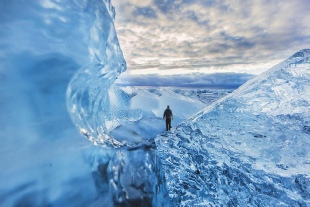
|
The North Pole is the point at the top of our planet where the Earth’s axis of rotation meets the surface. It is not a place. Unlike the South Pole, it is located at the centre of a frozen cean, the ice of which is constantly moving. It has no longitude because all lines converge there. It has no time zone, so you can choose the local hour. The North Pole, writes the Norwegian explorer Erling Kagge, “is like an abstract painting, freed from all form”. It is precisely because of its physical nothingness, he claims, that the North Pole has exerted such power over humanity. His achievement in this compelling, xpansive book is to present the North Pole in all its aspects – not just as a geographical point sought by generations of explorers, but also as a dream, myth and mirror. Kagge’s obsession with the North Pole began on his seventh birthday, when his parents
gave him his first globe. Almost three decades later, on March 8, 1990, he set off
on skis from Ellesmere Island in Canada, accompanied by fellow Norwegian explorer
Børge Ousland. They pulled sledges weighing 120kg and lived on oats, milk and dried
meat. Kagge’s only reading material was the New Testament, “the idea being to take
a book that contained as many thoughts as possible per gram”. The temperature hovered
around - For fifty- Sections on the expedition occur throughout the book’s central narrative, which tells
the story of humanity’s attempts to reach the North Pole, both physically and in
the imagination. Kagge takes us from the earliest recorded mention of the North Pole,
around 1500BC in the Hindu Vedas, through the revolutionary stargazing of Aristotle
and Ptolemy, to the cartographers of the Renaissance and the Enlightenment. As he
points out, when you look up at the night sky, “you will always be looking back in
time”. Light from the North Star takes 323 years to reach Earth, so we see it now
as it was in 1701 – twenty seven years before the Danish explorer Vitus Bering navigated
the strait between Asia and North America. A veteran sailor who has twice crossed
the Atlantic, Kagge writes well about the rat- This epic story reaches its climax in the early twentieth century, when two Americans both claimed to have been the first to stand at the North Pole. Robert Peary said that he had reached it in April 1909, but Frederick Cook insisted that he had done so a year earlier, in April 1908. Both men lacked conclusive evidence, and their dispute played out in the New York Times and New York Herald, the proprietors of which backed Peary and Cook respectively. The first uncontested arrival at the North Pole was an airborne expedition in 1926, led by the Norwegian explorer Roald Amundsen (obviously a hero of Kagge’s), which flew over the point but did not land. If both Peary’s and Cook’s claims were false, as historians now believe, the first people to reach this mythical spot on foot were the members of a secret Russian expedition in 1948, the details of which weren’t released until 1956. |
|
|
Kagge’s interest in the North Pole as it features in literature gives this history a fascinating extra dimension. In her novel The Blazing World (published in 1666 and considered one the earliest works of science fiction), the English poet, scientist and philosopher Margaret Cavendish “uses the North Pole as a tool in the fight for a woman’s right to fulfil her potential”. Her female protagonist escapes Britain’s chauvinistic strictures to rule over an egalitarian paradise at the top of the world. From Mary Shelley’s Frankenstein, partly set in the Arctic, Kagge extracts a vital lesson for explorers: “that you cannot and never will win against nature”. Captain Robert Walton is wise, not cowardly, to turn back the boat that rescues Frankenstein. Leo Tolstoy’s War and Peace, although not set in the Arctic, also contains valuable insights. While a prisoner of war, Pierre Bezukhov is forced on a march that kills most of the other men; but he experiences what Kagge describes as a “stoic calm he has never felt before”. Bezukhov shows us that “you suffer more in the mind than in reality; it is the perception of life that is decisive”. Combining erudition with his own experiences on the ice, Kagge develops what one
might call a philosophy of the North Pole. He traces the idea of an inner pole back
to ancient Sufi masters such as As- Why do something as difficult as trying to reach the poles? Why endure so much suffering voluntarily? Kagge followed up his 1990 expedition with the first solo, unsupported expedition to the South Pole in 1993 and summited Mount Everest in 1994, thus becoming the first person to complete the Three Poles challenge on foot. (Edmund Hillary beat him to it in 1953, but flew to the North Pole.) All those expeditions, he says, were undertaken to win the respect of his father, Stein, whose “masculine values” dominated his childhood. Kagge finds that hard to admit even now, in his early sixties – which might be why it doesn’t receive the attention it deserves. (His relationship with Stein is only mentioned briefly at the beginning and end of the book.) He shares his other motivations with all explorers: to embrace pain and risk, to strip life down to its essentials, to connect with nature. The goal is not a physical destination but a state of being, the point at which inner and outer exploration are indistinguishable: “You become your actions ... For me, one of the greatest experiences ... is the point when the past and future mean nothing, and I stop thinking and am completely present in the moment”. Today, anyone with a budget of about £20,000 can reach the North Pole on a polar cruise. One wonders if floating above this legendary point on an icebreaker would be a slightly anticlimactic experience; or whether, with nothing but ice and sky to look at, one would fully understand its symbolic importance. Either would be an appropriate response to somewhere that is not a place, but that has obsessed humanity for millenia. |


